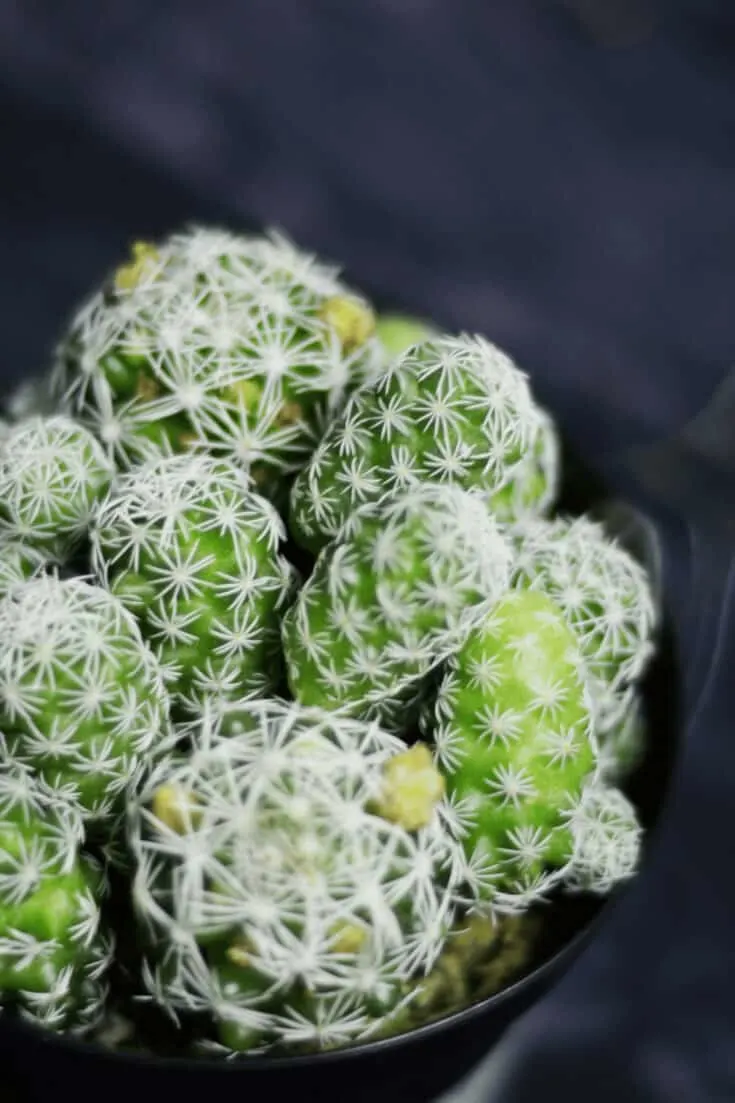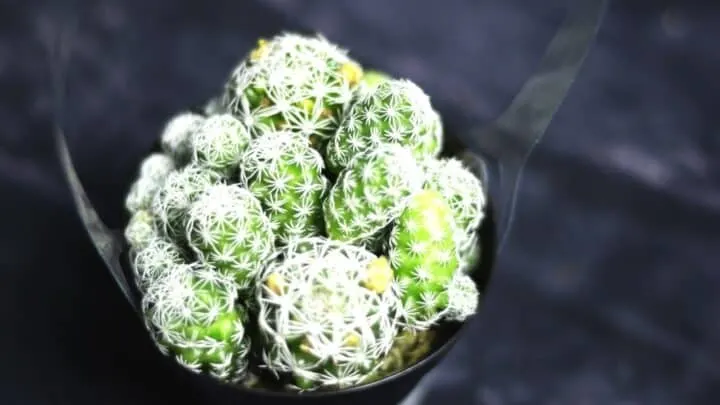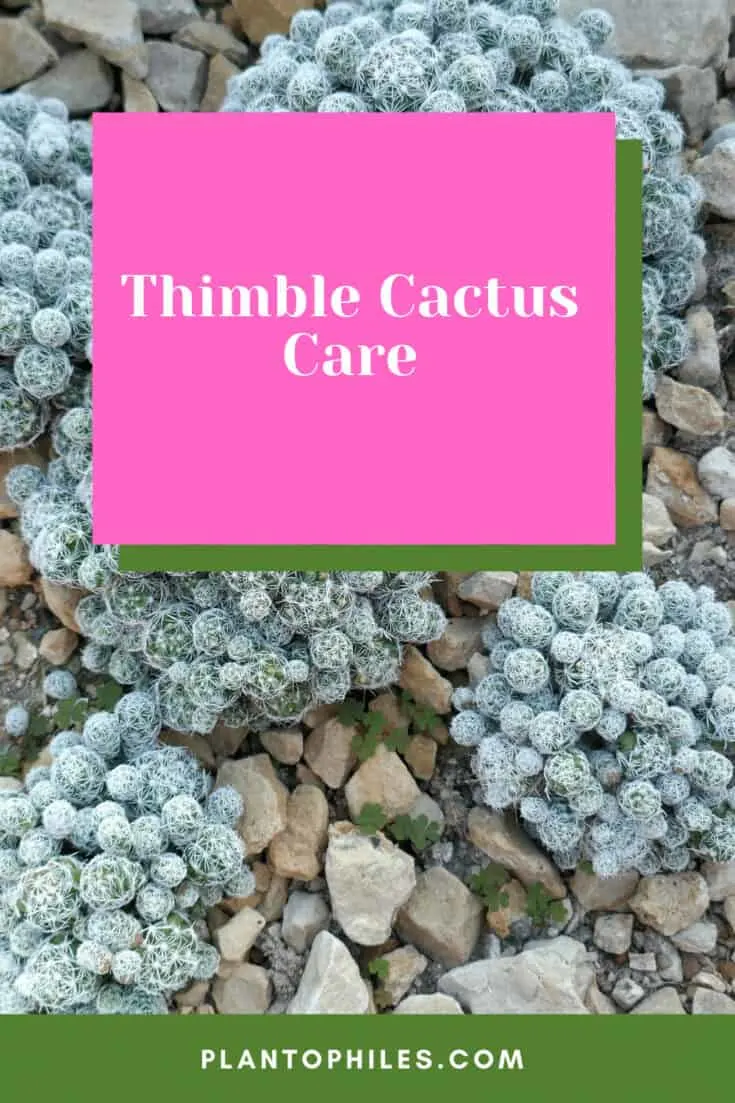Strolling around my local nursery, I came across the most adorable little Thimble Cactus plants.
I just had to buy a few to add to my cactus collection.
They are a delight to look at, with a deep forest-green color and soft, delicate white spines forming a lacy covering.
Like all plants, the Thimble Cactus has a tongue-twisting Latin Name.
This one is Mammillaria gracilis fragilis. It is also known as Powder Puff or Powder Puff Pincushion.
The Mammillaria genera is one of the largest in the cactus family according to the Iowa State University, with over 200 known species and varieties.
Most are native to Mexico. Some originate in the Caribbean, Colombia, Venezuela, Honduras, and Guatemala.
The Thimble Cactus looks fabulous next to my Feather Cactus, Mammillaria plumosa.
They both have a similar dark green color with feathery white contrasts.
Let’s take a closer look at how to care for these little beauties.
Thimble Cactus Care
To care for a Thimble Cactus give it well-draining soil that will dry out between waterings. A 50/50 mix of non-organic/organic works wonders. It thrives best in temperatures between 70°F and 80°F (21°C to 27°C). Temperatures should not be below 25°F to 30°F (-3.9°C to -1.1°C). The Thimble Cactus needs at least 6 hours of direct sunlight and 40% or less humidity. Fertilize once a month in spring and summer.
Table of Contents
Thimble Cactus Care Guide
Soil
The Thimble Cactus grows best in a potting mix between 50/50 non-organic/organic mix such as a peat/perlite mix.
In their native habitats, the Thimble Cactus is found growing solitary or in clumps.
Like most Mammillaria species, they enjoy rocky crevices that get at least 6 hours of bright sunshine before the sun moves away and they fall into cooling shade.
For ideal Thimble Cactus care, you need to give it a 50/50 non-organic/organic mix.
Here is a great home-made mix that you can make yourself.
You need 7 parts of lapillus or pozzolana, 3 parts of leaf or peat soil, 8 parts of coarse river sand, 0.3 grams of chalk per liter of compote, 3.4 grams of basic fertilizer per 1 per liter of compost.
If you want a simpler option, make up a 50/50 peat/perlite mix.
You can also include everyday materials like pumice or crushed bark, mulch, sterile garden compost, or organic manure.
Organic matter is eco-friendly, improves water retention, and keeps the roots warm and humid.
I love to use coco husk chips in my soil mix.
They are natural and environmentally friendly.
Coco Husk chips come from the pith inside a coconut husk.
Adding them is a great way to increase drainage and introduce extra aeration into the soil.
Try to grow your Powder Puff Pincushion in acidic to neutral soil with a PH ranging from 5.0 to 7.0.
Pro Tip: An easy way to reduce the acidity of your soil is to add pulverized limestone.
Limestone acts as a natural soil acid neutralizer by adding calcium and magnesium carbonates.
Light
The Thimble Cactus wants at least 6 hours of full sunlight every day. It loves bright light.
Try to place your plant on a south-facing window sill (if you are in the northern hemisphere).
I did notice that younger plants prefer reduced sunlight until they grow and become stronger. I would suggest 4 hours of bright sunlight for your baby Thimble Cactus, gradually increasing as it matures.
If you don’t want to keep moving your plant around (which can be a bind), place a sun-filter over the window to reduce the rays for part of the day.
I have my Thimble Cactus keeping company with a gorgeous Aloe Vera on a window ledge.
If you prefer to plant your Thimble Cactus outdoors, find a spot that gets sun for part of the day and then falls into the shade.
If you notice that your plant is changing color to orange or yellow, that is a sign of too much direct sunlight.
Watering
When it comes to watering care for your Thimble Cactus, it is best to use the soak-and-dry method.
This may sound daunting, but it is not! The idea is to thoroughly drench the plant and then allow it to dry out completely before watering again.
Pouring water into an indoor pot can become messy. Make sure that you have a pot with drainage holes at the base.
If you don’t, then the water will not be able to run out, the roots will become clogged and start to rot.
Place a plant saucer under your pot that is large enough to catch the water as it flows out.
If you live in an in-city apartment, stand the pot in your kitchen sink to prevent too much mess.
If you are lucky enough to have a garden, take the pot outdoors to do the watering.
Water your plant Spring and Fall. Minimal water is required during the Winter months.
If your plant looks droopy in Winter, give it a small dose of water. Use lukewarm water, it will prefer the mild temperature to a blast of icy cold.
For outdoor Thimble Cactus plants, keep an eye on rain and sun.
If you are getting too little rain, drench your plant with a hosepipe or watering can now and then, and allow it to dry out before watering again.
Remember this Thimble Cactus care tip: Your plant does not want to sit in constantly wet soil, it must be allowed to dry out. If not, it will eventually die.
Temperature
The Thimble Cactus will thrive best in temperatures between 70°F and 80°F (21°C to 27°C).
Think sun-baked, hot Mexican deserts. That is the home of your Thimble Cactus and it loves heat.
But, like most things in life, moderation is needed. Too much excessive heat is not good.
Your plant will thrive best in temperatures between 70°F and 80°F (21°C to 27°C).
It may tolerate short-term exposure to cold weather, but generally, it does not do well in the cold.
It will not survive in temperatures that drop between 25°F to 30°F (-3.9°C to -1.1°C).
If you live in a cold climate, consider growing your outdoor Thimble Cactus in a container. Y
ou can then bring it indoors or place it in a greenhouse during the winter months.
As you have probably guessed by now, the Thimble Cactus is not frost tolerant.
It may tolerate a small dose of light frost, but cold is not its strong suit.
If you live in a cold country, you will have to ensure that your plant is kept indoors in a warm room.

Thimble Cactus is also know as Mammillaria gracilis fragilis
Humidity
A Thimble Cactus loves a hot and dry climate and humidity of 40% or lower.
Humid conditions are not ideal for this succulent.
Its native habitat is a desert where the humidity will average below 40% for most of the year.
In general, homes are not overly humid and your plant will do well on a sunny window sill where it gets at least 6 hours of sunlight every day.
If you feel that your house is getting humid and stuffy, opening windows and allowing it to ventilate will sort out the problem in Summer.
In winter, it may be a bit more tricky as you don’t want to freeze. Place your plant in a position that has moving air. This will dampness from building up on the globes.
Tip to reduce humidity: Running a dehumidifier reduces and maintains the level of humidity in the air.
This is good for humans as well as your Thimble cactus. Too much humidity causes the growth of bacteria gives your living space a musty smell.
Fertilizer
Fertilize a Thimble Cactus once a month during the growing period. Stop feeding the plant in the winter months.
I am a great advocate of go-green living and that also applies to the plant fertilizers I use, both indoors and outdoors.
I stay away from chemical fertilizers whenever possible.
My number one care hack for Thimble Cactus is to buy or make my own natural organic fertilizer.
When potting your plant for the first time, this is the perfect opportunity to fertilize the soil and get it off to a good start.
I use rich, organic manure mixed in with the soil and water it very well.
In the growing months, I replenish it from time to time. You do not need to feed your Thimble Cactus during the dormant Winter months.
If you are using chemicals in your garden, perhaps consider a weaning-off process over the next few months.
Dilute your chemicals to double or triple that stated in the instructions.
Slowly start to introduce natural fertilizers. If you are happy that the plants are growing well, do away with the chemicals.
Natural organic fertilizers can be made using mulch, peat, coco husks, peat, perlite, pumice, and crushed bark.
A small compost-making machine is a great addition to any garden and makes good use of grass cuttings, fallen leaves, and dead flowers.
Propagation
The Thimble Cactus can be propagated from offsets.
Offsets form in clusters around the base of the mother plant. They can easily be lifted off and divided.
Once removed, allow to dry on a paper towel for a few days.
The offset will take root fairly fast after being placed in a pot with a rich soil. Propagating your own plants is a fun and rewarding experience, why not give it a try?
Growth
Thimble Cactus grows as a separate plant or in clusters.
The body is a lovely forest-green color, covered by delicate white spines that radiate in a star shape and form a dense covering over the surface. The offsets sprout from the main plant forming a lovely cluster.
The plant has a cylindrical shape, much like an upside-down thimble, giving it its name.
A mature Mammillaria gracilis fragilis plant is around 3″ to 5″ (7.5cm to 12.5cm) tall. It spreads to around 3″ to 4″ inches (7.5cm to 10cm).
The best Thimble Cactus growing condition is in a bright, sunny spot with low humidity.
This plant is an evergreen succulent perennial.
Thimble Cactus care does not require pruning. If an offset does not look healthy, simply remove it with a sterile, sharp knife.
The flowers of the Thimble Cactus are a creamy white bell-shape with a hint of yellow inside.
They appear in Spring or in late Summer to Autumn. The flowers are small and delicate, only about 1/2” (12mm) in length.
Thimble Cactus makes an attractive indoor pot plant and looks fabulous in a small outdoor rock garden.
Potting
Your Powder Puff Pincushion Cactus is happy in a smaller pot as the roots do not grow very deep.
When potting, don’t dig a deep hole. Rather place the plant on top of the potting mix.
This allows the roots to go down to get moisture without the plant sitting in wet soil.
Note that the plant doesn’t need much substrate.
It is happy in a well-drained mix of gritty sand, peat, mulch, and coco.
Repotting can be done when the plant comes out of hibernation in Spring. You only need to do this once every 2 to 3 years.
Check the roots for damage and remove them if found.
Repot into fresh soil to boost growth. Small terracotta planters are an attractive choice for a window sill.
Care tip: Ensure that the container has drainage holes so that the water can flow out. You don’t want the roots to rot in stagnant water at the base of the pot.
Propagate Thimble Cactus from offsets
- This is best done in early Spring to late Summer
- Look for the offsets that form around the main base of the mother plant
- You will see that they can easily be lifted and divided
- Use a sterile sharp knife or a pair of tongs
- Allow the offset to dry out on a paper towel for a few days
- You will see that a callus forms over the cut surface
- Once the callus has formed, place the new plant in a pot filled with potting soil mixture
- Keep in a warm place until new roots emerge
- Repot carefully into your permanent pot or garden spot
Common problems with Thimble Cactus
Pest Control
Like all plants, your Thimble Cactus can be attacked by pests. Common pests are spider mites, fungus gnats, and scale insects.
It can be difficult to control these pests as they are very tiny and hide inside the plant.
One method to rid your plant of pests is to use a diluted rubbing alcohol solution.
Bacteria or Fungal Disease
This is mostly caused by excessive watering.
Check your plant for rot that appears as black spots around the base of the plant.
If you see this, take your Thimble Cactus out of the container and remove any rotting roots and offsets. Repot into a new pot filled with dry soil.
Bleaching or losing its green color
If you notice that your Thimble Cactus is changing color to an orange or yellow shade, it is most probably due to too much or too little direct sunlight.
A similar indication is a bleached appearance.
Ensure that your plant is in a spot where it gets 5 to 6 hours of direct sunlight per day. Too much is not good and too little is also bad.
Puckering flesh
This is a sign of too little water. A cactus is healthy when it is plump and the flesh has a springy texture.
Although these plants need minimal water, they do need some.
If they are not getting enough, they draw water from their reserves and you will see that the plant looks like it is puckering, or getting wrinkles.
Tips to grow Thimble Cactus problem-free
- Avoid overwatering your Thimble Cactus
- Use the soak-and-dry method
- Ensure that your plant has 6 hours of sun every day
- Ensure that your plant is in a bright spot, it does not enjoy the dark
- Do not grow in cold conditions
- Do not grow in very humid conditions
- Fertilize only during the growing season and use organic soil additives
- Grow Thimble Cactus in terracotta pots to allow the roots to dry out
Frequently asked questions about the Thimble Cactus
Can a Thimble Cactus grow indoors?
A Thimble Cactus can grow indoors in a small pot. You can also include it in a small rock garden on a patio, or even use it to decorate a fairy garden.
Is Thimble Cactus easy to care for?
Thimble Cactus is a great plant for beginners. It requires very little maintenance and is hardy and strong. You don’t want to be discouraged by losing your first plant. The Thimble Cactus will flourish in sunlight and grow into an attractive green cluster with a unique white lacy covering.
Is Thimble Cactus poisonous?
A Thimble Cactus is not poisonous. It also does not have any prickly thorns that will hurt children. It will not cause any harm if ingested. However, it is best to keep them away from children and pets.
Conclusion About Thimble Cactus Care
Do you want a small plant that will delight your family and friends? The Thimble cactus is eye-catching and easy to care for.
It is a great choice for a beginner wanting to start a small collection of cactus varieties.
Once you are successful in growing your Thimble Cactus, you can add other Mammillaria plants to your collection.
Take a look at the lovely Mammillaria Bocasana, Mammillaria Carmenae, and the Mammillaria Elegans.

Daniel has been a plant enthusiast for over 20 years. He owns hundreds of houseplants and prepares for the chili growing seasons yearly with great anticipation. His favorite plants are plant species in the Araceae family, such as Monstera, Philodendron, and Anthurium. He also loves gardening and is growing hot peppers, tomatoes, and many more vegetables.



